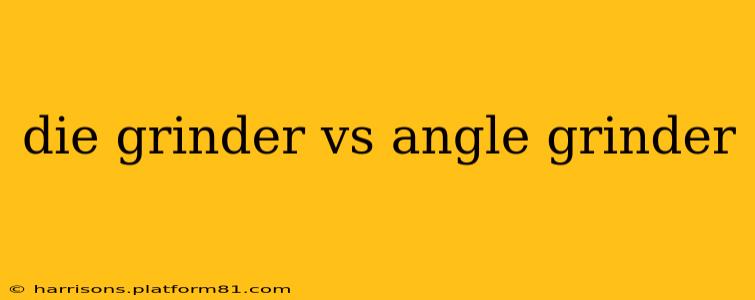Choosing between a die grinder and an angle grinder often leaves DIY enthusiasts and professionals scratching their heads. Both are power tools used for grinding, but their distinct designs and capabilities cater to different applications. This comprehensive guide delves into the nuances of each tool, helping you determine which one best suits your needs. We'll explore their strengths, weaknesses, and ideal use cases, ensuring you make an informed decision.
What is a Die Grinder?
A die grinder is a compact, high-speed rotary tool typically used for intricate grinding, polishing, and finishing tasks. Its small size and maneuverability allow for precision work in tight spaces. The name "die grinder" stems from its original use in the die-making industry, where its precision was invaluable for shaping and refining dies. These grinders are known for their high RPM (revolutions per minute), offering aggressive material removal when needed.
Advantages of a Die Grinder:
- Precision and Control: The smaller size and lighter weight offer excellent control, especially in tight or confined spaces.
- High RPM: Ideal for detailed work and aggressive material removal in smaller areas.
- Versatility: A wide range of accessories, such as sanding drums, rotary files, and polishing wheels, expand its functionality.
Disadvantages of a Die Grinder:
- Limited Cutting Capacity: Not suited for heavy-duty cutting or grinding of large materials.
- Higher Vibration: The high speed and smaller size can lead to increased vibration, potentially causing fatigue during prolonged use.
- Less Powerful: Generally less powerful than angle grinders for large-scale material removal.
What is an Angle Grinder?
An angle grinder, also known as a side grinder, is a more powerful tool designed for heavier-duty applications. Its larger size and more robust construction allow for tackling tougher materials and larger projects. The name comes from the angled head that houses the grinding disc, facilitating easier access to various work surfaces. Angle grinders excel at cutting, grinding, and polishing a variety of materials.
Advantages of an Angle Grinder:
- High Power: More powerful than die grinders, enabling faster material removal and cutting through thicker materials.
- Heavy-Duty Applications: Ideal for tasks like cutting metal, concrete, and stone.
- Wide Range of Discs: Offers a broader selection of abrasive discs for various materials and applications.
Disadvantages of an Angle Grinder:
- Less Precise: Its larger size and less maneuverability make it less suitable for intricate detail work.
- Kickback Risk: Powerful angle grinders can cause kickback if not handled properly, posing a safety risk.
- Less Control in Tight Spaces: The larger size hinders precise work in confined areas.
Die Grinder vs. Angle Grinder: Key Differences Summarized
| Feature | Die Grinder | Angle Grinder |
|---|---|---|
| Size | Small, Compact | Larger, Bulkier |
| Power | Less Powerful | More Powerful |
| Precision | High | Lower |
| RPM | Very High | High to Medium |
| Ideal Use Cases | Detail work, finishing, polishing | Heavy-duty grinding, cutting |
| Safety Concerns | Less risk of kickback | Higher risk of kickback |
What are the common uses for a die grinder?
Die grinders are incredibly versatile and find their niche in applications demanding precision and control. Common uses include:
- Deburring: Removing sharp edges from metal parts.
- Polishing: Achieving a smooth, high-luster finish on metal, plastic, or wood.
- Engraving: Creating designs or markings on various surfaces.
- Cleaning welds: Removing excess weld material for a cleaner finish.
- Removing rust and corrosion: Precisely targeting areas of rust or corrosion without damaging surrounding material.
What are the common uses for an angle grinder?
Angle grinders are workhorses capable of handling more demanding tasks. Their common applications include:
- Cutting metal: Severing pipes, rods, and other metal components.
- Grinding welds: Smoothing welds and removing excess material.
- Cutting concrete and stone: Used in demolition and construction for cutting materials.
- Sharpening tools: Sharpening blades, chisels, and other tools.
- Surface preparation: Removing old paint, rust, and other surface imperfections.
Which grinder is right for me?
The best grinder for you depends entirely on your needs and the tasks you'll be performing. If you require precision and control for detailed work, a die grinder is the better choice. However, if you need a powerful tool for heavy-duty grinding, cutting, or material removal, an angle grinder is the more suitable option. Consider the specific applications, material types, and required level of precision when making your selection. Always prioritize safety and use appropriate personal protective equipment (PPE) such as eye protection, hearing protection, and gloves when operating either tool.
